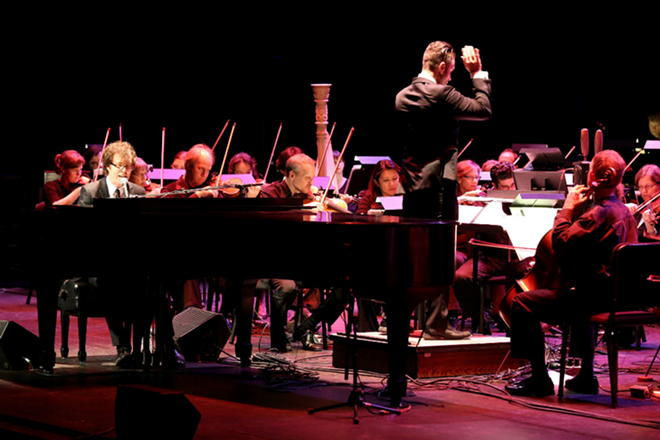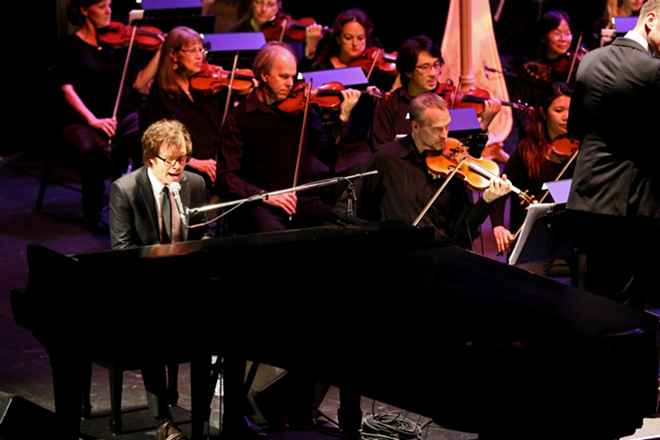Concert review: The Ben Folds Orchestral Experience at the Straz Center (original) (raw)
Drunkcameraguy
Ben Folds with The Florida Orchestra at the Straz Center Fri., Nov. 7, 2014
I’m a latecomer to the Ben Folds fan club. Like anyone who listened to the radio in the last couple of decades, I knew the refrain of his big indie hit with Ben Folds Five, 1997’s “Brick” (“She's a brick and I’m drowning slowly”). But I really got to appreciate him from watching NBC’s The Sing-Off, in which his articulate but gentle critiques set him apart from just about any judge ever seen on a TV talent contest. So my level of familiarity put me roughly in the middle, knowledge-wise, of the audience for the Ben Folds Orchestral Experience with The Florida Orchestra. [Text by David, photos by DCG.]
DrunkCameraguy.com
Concert review: The Ben Folds Orchestral Experience at the Straz Center
“This is a different crowd,” I overheard one concertgoer say, and I’d wager it was — more plaid shirts, earlobe plugs, chunky eyeglasses and selfie-takers than have ever been seen at a TFO concert, mixed in with the usual dressed-up senior crowd. The generation gap was evident in the conversation I heard behind me, during which an older gentleman inquired of his youngish neighbor whether he’d ever heard of “this fella” before, and was given an encyclopedic earful of data about the Ben Folds oeuvre, from concert dates to rhyme schemes to the stories behind the lyrics.
But whether you were a newbie or a devotee, there’s no way you left the Straz Friday night without a deep appreciation for Folds's droll deadpan and amazing musical chops. I mean, who else can come up with a song lyric in the afternoon about a tour city (rhyming “Tampa” with “tramp-stampa,” among other inspired choices), then make up a melody at the piano, score it with an orchestra and chorus, and perform the song — all in real time in front of a live audience?
Drunkcameraguy
Concert review: The Ben Folds Orchestral Experience at the Straz Center
The city-specific original is a regular feature of the Ben Folds repertoire, and just one of the astonishments of the aptly titled Orchestral Experience, which he has performed with symphony orchestras all over the world. Here's another: After a hilarious disquisition on how to write a piano concerto (“Get your big hits in the first movement”), he plays the third movement of his own piano concerto, a Gershwinian slambang piece of work that opens with the piano in mischievous dialogue with the orchestra, then goes all out, Folds tweaking the strings and playing the keyboard with jackhammer force.
And while you might think that his pop music — plaintively sung, character-driven story songs with intricate lyrics — might be overwhelmed by soaring strings and blaring horns, it’s a credit to his musical savvy and the adroit baton of guest conductor Jacomo Bairos (who, as Folds remarked, “lived up to his badass name”) that soloist and musicians mostly established an equal partnership. In the simultaneously angry and heartbreaking “Picture Window,” set in a hospital room on New Year’s Eve (lyrics by poet/novelist Nick Hornby), Folds and orchestra brought the number to an almost-whispered conclusion. At the other extreme, the ensemble swung hard in a rollicking rendition of “Steven’s Last Night in Town,” sounding like the old Johnny Carson-era Tonight Show band gone slightly off the rails. And in “Cologne,” the USF Chamber Singers built a powerful sense of the inexorable in the pounding “Four, three, two, one” of the chorus.
Drunkcameraguy.com
Concert review: The Ben Folds Orchestral Experience at the Straz Center
Cheeringly enough for a newspaper guy, at least two of the songs referenced newspapers — “Cologne” was inspired by a USA Today story about the murderous diaper-wearing astronaut Lisa Nowak, and “Fred Jones Part 2” was about a laid-off journalist’s last day at work. (OK, neither was exactly a hopeful sign.) In “Fred Jones” and particularly “Gracie,” written for his twin daughter when she was 4, the quiet humanity of Folds’ songwriting, and the sweet clarity of his piano and vocals, glowed brightly, recalling early Elton John.
But what really shone was Folds’s deep admiration for the continued value of symphony orchestras; he even stopped the music for a bit to proselytize that point. Granted, he was preaching to the choir a bit — (and we actually were the choir later on, when he led us in group vocalizing). But he left me not just with a renewed respect for the artist, but with a sense of new possibilities for symphony concerts (and audiences) to come.



